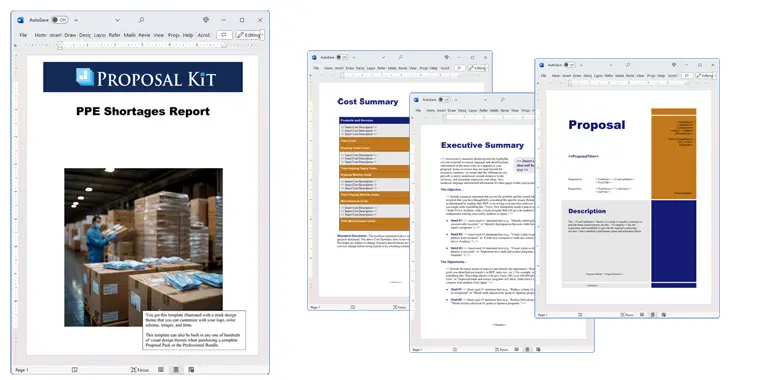How to write your PPE Shortages Report
We include this 15 page layout with every Proposal Pack. If you want this template to have a different visual design theme than the one illustrated here, purchase any Proposal Pack design and create this template using the purchased design theme. This template is included in every Proposal Pack. If you get a Proposal Pack or the Professional Bundle, you can also make any variation of this template with different chapters to suit your needs.
We typically include more chapters in the templates than most people will need to give everyone more variety in the chapters they may need. You can trim down a long template by removing pages you do not need or combining multiple chapter topics into one page.
 DOWNLOADABLE, ONE-TIME COST, NO SUBSCRIPTION FEES
DOWNLOADABLE, ONE-TIME COST, NO SUBSCRIPTION FEES If you need this template on DVD media order from our Amazon shop.
If you need this template on DVD media order from our Amazon shop.
You can also create countless variations of this document to suit your needs using the included library of 2200+ chapters if ordering a Proposal Pack or Pro Bundle.
 What Our Clients Say
What Our Clients SayI ran out my first proposal and it was fantastic! Thank you!"
Related Article
Related Video
Related Templates
- Reserve Study
- SWOT Analysis Report
- Supply Chain Disruption and Risk Report
- Medical Equipment Distribution and Sales Proposal
- Supply Chain Logistics Project Proposal
- Procurement and Consignment Services Proposal
What's the best way to write your PPE shortages report?
Proposal Kit provides a comprehensive and adaptable solution when documenting and analyzing PPE shortages and their impact on the supply chain. With the Proposal Kit template library and Wizard software program, you'll find specialized tools tailored to this need, including a sophisticated line item quoting database for managing cost summaries, quotes, estimates, budgets, and other financial details.
Are you tasked with writing such a report? If so, the Proposal Kit is equipped to streamline your process and enhance your presentation. Proposal Kit is used to write reports, studies and business documents in addition to writing proposals.
What Types of Projects Are PPE Shortages Report Written For?
PPE shortage reports are crucial for various situations, primarily focused on evaluating and addressing gaps in the supply and distribution of personal protective equipment. Here are some examples of projects where such reports are written:
- Hospital inventory management
- Government health department assessments
- Disaster response planning
- Non-profit outreach programs
- International aid distribution
- Medical research studies
- Public health policy development
- Corporate health and safety audits
- Supply chain risk analysis
- Manufacturing workflow evaluation
- Trade association resource planning
- Educational institution safety checks
- Construction site safety gear audits
- Pharmaceutical PPE needs analysis
- Logistics company equipment tracking
- Retailer stock-level evaluations
- Wholesale distributor negotiations
- Emergency medical services assessments
- Dentistry practice safety upgrades
- Veterinary clinic health standards assessments
Chapters this template is built with
No single template fits all situations; however, Proposal Kit's software allows you to create custom reports that fit your needs. Below is a starting point of chapters from Proposal Kit's extensive library that could be used in your report:
Introduction
This template sets the stage for the report by providing background information on the PPE shortages issue and outlining the document's objectives. It might include historical data on PPE usage, the impact of shortages on healthcare and other sectors, and a brief overview of the key topics to be covered in the report.
Future Proofing
Discuss strategies to prevent future PPE shortages, drawing from lessons learned during prior shortages. This could involve recommendations for diversifying suppliers, increasing stockpile sizes, implementing better forecasting techniques, and investing in local manufacturing capabilities to reduce reliance on international sources.
Sourcing and Fulfillment
Analyze current sourcing strategies and fulfillment capabilities, suggesting improvements or alternatives. This chapter might include a review of current suppliers, an assessment of their reliability, and suggestions for alternative suppliers or new fulfillment methodologies to ensure a steady supply of PPE in the future.
Imports
Examine the role of imports in PPE supply and how changes in international trade policies or logistics could affect availability. This could include a review of import tariffs, shipping delays, geopolitical factors impacting the flow of PPE from international sources, and potential strategies to mitigate these risks.
Vulnerabilities
Identify key vulnerabilities within the supply chain that could lead to PPE shortages, including financial, logistical, or geopolitical factors. This chapter might detail specific weak points such as single-source dependencies, transportation bottlenecks, or financial instability among suppliers and suggest ways to address these vulnerabilities.
Shortages
Data and research support detailed specific areas where shortages are occurring. This chapter would include quantitative data on PPE usage and shortages, segmented by region, healthcare facility type, or other relevant metrics, providing a clear picture of where the most critical gaps exist.
Supplies
Catalog current supplies, including types, quantities, and conditions, highlighting any gaps in inventory. This would involve a detailed inventory of PPE on hand, categorized by type (e.g., masks, gloves, gowns), condition (e.g., new, used, expired), and location, identifying areas where supplies are insufficient to meet demand.
Stockpiles
Evaluate existing stockpiles for adequacy in meeting current and future needs. This chapter could include an analysis of stockpile sizes relative to projected demand, the condition and rotation of stockpiled items, and recommendations for increasing or better-managing stockpiles to ensure they are sufficient during future surges in demand.
Summary
Sum up the report's findings, emphasizing major points and recommended actions. This would include a high-level overview of the key data points and trends identified in the report and a concise list of actionable recommendations for stakeholders to consider.
Availability
Discuss the current state of PPE availability and project future trends based on the analysis. This chapter would include current availability metrics, such as inventory levels and fulfillment times, along with future supply and demand projections based on trends and various situations.
Supply Chain
Provide an in-depth look at the entire supply chain involved in PPE provision, from manufacturing to end-use. This could include mapping out the supply chain, identifying key nodes and flows, and analyzing how each stage contributes to overall PPE availability and where improvements can be made.
Suppliers
Profile key suppliers, their capacities, reliability, and the quality of their products. This chapter will include detailed profiles of major suppliers, including their production capacities, reliability track records, quality control measures, and any certifications or compliance with standards, helping to assess their suitability as long-term partners.
Use cases for this template
Navigating Hospital Supply Challenges
The Challenge
At the height of the pandemic, hospitals everywhere were experiencing dire shortages of personal protective equipment (PPE). Jane, a procurement manager at VitaHealth Systems, was particularly alarmed by the dwindling stock of surgical masks. The staff grew anxious, and the risk to patients and healthcare workers escalated. Jane realized that an immediate, structured approach was needed to address the critical shortages and secure a stable supply of masks.
The Solution
Jane turned to Proposal Kit to write a comprehensive PPE shortages report. Using the robust template library, she systematically documented the current inventory levels, identified the most pressing deficits, and developed a restocking plan. The templates helped her organize the collected data into a coherent and compelling narrative, which included actionable strategies to mitigate the immediate crisis and prevent future shortages.
The Implementation
Using Proposal Kit's customizable templates, Jane incorporated real-time data on mask usage rates, supplier lead times, and shipment delays. She tailored the Shortages and Suppliers chapters to present a clear picture of the hospital's needs and the inefficiencies in the current procurement process. Jane also used the Future Proofing chapter to outline long-term strategies for maintaining a reliable supply chain, including diversification of suppliers and establishing emergency stockpiles.
The Outcome
The comprehensive report Jane produced became a tool for VitaHealth Systems. It provided a clear, data-driven basis for decision-making, leading to a revamped procurement strategy. The hospital forged new partnerships with reliable suppliers, improved its stock management system, and developed a more resilient procurement process. As a result, mask availability stabilized, alleviating staff anxiety and ensuring better protection for healthcare workers and patients.
Enhancing Readiness for a Non-Profit
The Challenge
Mike, the director at SafeGuard Health, was tasked with enhancing the non-profit's readiness to respond to future crises. The organization had previously struggled with unreliable PPE supplies during emergencies. To address this, Mike must prepare a Request for Proposal (RFP) to attract and secure long-term partnerships with dependable PPE suppliers. The challenge was to create a detailed and compelling RFP that would appeal to top-tier suppliers.
The Solution
Mike decided to use the Proposal Kit to create the RFP. The extensive library of templates provided the structured approach he needed to clearly articulate the non-profit's requirements and expectations. By customizing the Suppliers and Supply Chain chapters, he highlighted the organization's critical needs and the criteria for supplier selection, ensuring that the RFP was comprehensive and persuasive.
The Implementation
Mike tailored the RFP using the Proposal Kit's templates, ensuring each section was precise and compelling. The Suppliers chapter detailed the non-profit's expectations regarding product quality, delivery timelines, and pricing structures. The Supply Chain chapter offered insights into the organization's logistics and distribution needs. By organizing the information in a clear and logical format, Mike made it easier for potential suppliers to respond.
The Outcome
The detailed RFP, created with the Proposal Kit, attracted several high-quality suppliers. SafeGuard Health was able to establish partnerships with reliable companies that met its criteria. These new partnerships significantly improved the non-profit's PPE stocks, ensuring it was better prepared for future health crises. The RFP process also fostered long-term relationships, positioning SafeGuard Health as a preferred partner in the industry.
Streamlining Safety in Education
The Challenge
Sarah, an administrator at New Horizons Academy, was challenged to assess the school's PPE needs. With a limited timeframe and a pressing deadline, she needed to compile a thorough report to secure additional funding for safety measures. The challenge was to gather accurate data quickly and present it in a way that would convince the board of the immediate need for increased PPE resources.
The Solution
Sarah turned to Proposal Kit and an AI writing tool to expedite the report preparation. Proposal Kit provided the templates to structure the report, while the AI tool helped her generate and refine content. By integrating insights from the AI analysis of the school's website and current safety protocols, Sarah created a data-driven PPE shortages report.
The Implementation
Sarah customized the Supplies and Vulnerabilities chapters using the Proposal Kit's templates. The Supplies chapter provided a detailed inventory of the current PPE stocks, while the Vulnerabilities chapter highlighted potential risks and gaps in safety measures. The AI tool enabled her to analyze and incorporate relevant data quickly, ensuring the report was comprehensive and persuasive.
The Outcome
The timely and thorough report Sarah produced had a significant impact. The board was convinced by the clear and well-documented needs outlined in the report, leading to an increased budget for student and staff safety measures. This allowed New Horizons Academy to purchase additional PPE, improve safety protocols, and ensure a safer environment for everyone on campus. The successful use of Proposal Kit and AI tools demonstrated the efficiency and effectiveness of modern solutions in addressing urgent administrative challenges.
Conclusions and Recommendations
From writing detailed reports on PPE shortages to managing complex supply chain analyses, Proposal Kit provides the tools necessary to articulate your needs, propose solutions, and execute plans. Whether addressing hospital shortages, preparing for non-profit operations, or ensuring safety in educational settings, Proposal Kit's customizable templates and sophisticated quoting system streamline the proposal process, helping you achieve timely and impactful results.
Also Known As
This template may also be referred to in different ways or be used in more specialized situations, such as:
- Personal Protective Equipment Analysis
- PPE Supply Gap Report
- Protective Gear Shortage Overview
- Safety Equipment Supply Report
- Health Protection Gear Report
- PPE Availability Assessment
- PPE Needs and Solutions Document
- Equipment Shortfall Analysis
- Protective Supply Chain Report
- PPE Management and Strategy Review
Abstract
 The global personal protective equipment (PPE) shortage has emerged as a challenge in disease control and infection prevention, particularly during health crises like the COVID-19 pandemic. Healthcare personnel, including doctors, nurses, and other staff, have faced severe risks due to the lack of proper PPE, such as N95 masks, face shields, and medical masks, leading to increased vulnerability to infectious diseases. The World Health Organization and the Centers for Disease Control have highlighted the critical need for coordinated efforts to address PPE shortages, which have been exacerbated by supply chain issues, export restrictions, and panic buying.
The global personal protective equipment (PPE) shortage has emerged as a challenge in disease control and infection prevention, particularly during health crises like the COVID-19 pandemic. Healthcare personnel, including doctors, nurses, and other staff, have faced severe risks due to the lack of proper PPE, such as N95 masks, face shields, and medical masks, leading to increased vulnerability to infectious diseases. The World Health Organization and the Centers for Disease Control have highlighted the critical need for coordinated efforts to address PPE shortages, which have been exacerbated by supply chain issues, export restrictions, and panic buying.
The administration's invocation of the Defense Production Act aimed to boost domestic production of important medical supplies and mitigate short-supply issues. However, staffing shortages, price gouging, and limited raw materials continue to hinder efforts to provide PPE to frontline health workers, nursing homes, and other medical facilities.
Effective strategies to combat these challenges include prioritizing occupational safety through proper PPE distribution and infection control measures. A mixed methods approach, incorporating data from surveys and reports, can help identify vulnerabilities and guide future prevention efforts. Researchers advocate for increased local manufacturing capabilities and diversification of suppliers to reduce dependency on international sources. Efforts must also focus on preventing hoarding, ensuring equitable distribution, and maintaining a robust supply chain to support healthcare providers in protecting lives.
 Proposal Kit offers sophisticated tools like complex document assembly and automated line-item quoting to aid in writing comprehensive PPE shortage reports. These reports provide evidence-based recommendations that can guide stakeholders in enhancing the resilience of healthcare systems against future supply disruptions. By using Proposal Kit's extensive content libraries, healthcare administrators and other key figures can develop tailored reports that communicate the urgency and importance of addressing PPE shortages, ultimately leading to improved health outcomes and preparedness.
Proposal Kit offers sophisticated tools like complex document assembly and automated line-item quoting to aid in writing comprehensive PPE shortage reports. These reports provide evidence-based recommendations that can guide stakeholders in enhancing the resilience of healthcare systems against future supply disruptions. By using Proposal Kit's extensive content libraries, healthcare administrators and other key figures can develop tailored reports that communicate the urgency and importance of addressing PPE shortages, ultimately leading to improved health outcomes and preparedness.
The personal protective equipment shortage has posed severe challenges worldwide, affecting healthcare systems' ability to combat the COVID-19 pandemic. The World Health Organization has continuously highlighted the critical need for global coordination to address the inadequacies in PPE supply chains. Across countries, healthcare workers on the front line, including physicians and nurses, have faced immense risks due to the lack of proper PPE, such as N95 masks, respirators, and other important medical supplies. This shortage has been more pronounced since late March, when the pandemic's rapid spread led to heightened demand and subsequent rationing.
The administration's use of the Defense Production Act aimed to enhance domestic production and provide PPE to those in need. Despite these efforts, the Centers for Disease Control and other agencies have warned of continuing gaps and the need for improved strategies to ensure that healthcare personnel receive adequate protection. Researchers have pointed to the importance of incentives for local manufacturers to increase production and diversify the supply market to mitigate future shortages.
 Proposal Kit offers invaluable assistance in preparing detailed reports on PPE shortages by using its sophisticated document assembly and extensive template libraries. These tools allow healthcare administrators, universities, and organizations to synthesize PPE shortage data, identify critical gaps, and propose actionable solutions. The ultimate aim is not only to provide a comprehensive analysis of the current situation but also to guide future policy decisions and ensure robust preparation for potential future crises.
Proposal Kit offers invaluable assistance in preparing detailed reports on PPE shortages by using its sophisticated document assembly and extensive template libraries. These tools allow healthcare administrators, universities, and organizations to synthesize PPE shortage data, identify critical gaps, and propose actionable solutions. The ultimate aim is not only to provide a comprehensive analysis of the current situation but also to guide future policy decisions and ensure robust preparation for potential future crises.
Moreover, Proposal Kit helps entities to address issues beyond PPE, such as the provision of hand sanitizer, goggles, and other items necessary for infection control. By facilitating clear communication and coordination among stakeholders, the tool helps mitigate the failure of supply systems and enhances the ability of healthcare facilities to prioritize and protect their employees.
The American Journal and various studies have documented the adverse impacts of the PPE shortage, emphasizing the need for planning and the adoption of technology to streamline procurement processes. The commitment to resolving these issues is crucial to safeguarding public health and ensuring the well-being of healthcare workers as they continue to serve families and communities during this unprecedented time.
 The personal protective equipment shortage during the COVID-19 pandemic has underscored critical vulnerabilities within the global supply chain for medical supplies. The World Health Organization and the Centers for Disease Control have both called for urgent action to address these deficiencies and ensure that healthcare systems can provide proper PPE, including N95 masks and respirators, to their employees. The pandemic has highlighted the need for robust data collection and analysis, as detailed in various studies published in the American Journal, which emphasize the importance of accurate PPE shortage data for informed decision-making.
The personal protective equipment shortage during the COVID-19 pandemic has underscored critical vulnerabilities within the global supply chain for medical supplies. The World Health Organization and the Centers for Disease Control have both called for urgent action to address these deficiencies and ensure that healthcare systems can provide proper PPE, including N95 masks and respirators, to their employees. The pandemic has highlighted the need for robust data collection and analysis, as detailed in various studies published in the American Journal, which emphasize the importance of accurate PPE shortage data for informed decision-making.
The administration's invocation of the Defense Production Act aimed to bolster domestic manufacturing capabilities to provide PPE and other medical supplies more. Despite these efforts, significant challenges remain, particularly concerning the distribution and availability of PPE types that are critical for infection prevention. As of late March, many countries reported that half or more of their healthcare facilities experienced substantial PPE shortages, affecting their ability to conduct COVID-19 testing and protect their staff from illness.
One-third of healthcare facilities have had to reconsider the reuse of PPE due to supply limitations, despite guidance from health agencies advocating for the safe and proper use of these protective items. Researchers have called for comprehensive strategies to be developed by universities and other institutions to enhance local production capabilities and reduce dependency on international suppliers. This shift is necessary to afford healthcare providers the resources they need and prevent further strains on the system.
The CDC and other centers have emphasized the importance of clear communication and coordination among employers, government bodies, and the medical community. As the virus continues to spread, Congress has been urged to implement measures that support the sustainable distribution of PPE and mitigate the risk of facilities becoming infected due to inadequate protection. Addressing these challenges requires a multi-faceted approach that considers the socioeconomic impacts, the role of technology in improving supply chain efficiency, and the need for ongoing investment in healthcare infrastructure.
Proposal Kit plays an important role in facilitating this process by providing structured templates that help organizations compile thorough PPE shortage reports. These reports offer answers and actionable strategies to improve PPE availability and distribution, ultimately ensuring that healthcare workers are well-equipped to serve their communities and combat the spread of pathogens. Further, they encourage stakeholders to engage in proactive planning and policy development to prevent future shortages and better prepare for health emergencies.
Frequently Asked Questions
What should be my first step in writing a PPE shortages report?
The first step in writing a PPE shortages report is to gather comprehensive data on current PPE inventories and usage rates. You'll need to collect information from various departments or sectors to understand the shortages accurately. This initial data collection sets the foundation for the report, enabling you to identify critical gaps and areas that require immediate attention. Proposal Kit's templates can help you efficiently organize this data, ensuring you cover all necessary topics from the start.
How do I highlight critical shortages in the report?
Use the Shortages chapter within the Proposal Kit templates to highlight critical shortages in your PPE reports report. This section should include detailed analytics, trend data, and visual aids like charts or graphs to illustrate where shortages are most severe clearly. By presenting this information in a structured and data-driven manner, you can make a case for immediate action and resource allocation to address the shortfalls.
What financial details should be included in a PPE shortages report?
A comprehensive PPE shortages report should include detailed financial information such as cost summaries, budget forecasts, and funding needs. Use the line item quoting database provided by Proposal Kit to detail the financial topics accurately. This database will help you create clear and precise financial statements, which are crucial for stakeholders to understand the economic impact of the shortages and the resources required to mitigate them.
How can I make the PPE shortages report compelling to stakeholders?
To make your PPE shortages report compelling to stakeholders, focus on the Summary and Future Proofing chapters. These sections should outline key findings and actionable strategies that address stakeholders' interests and concerns. You can engage stakeholders by emphasizing the potential risks of inaction and providing clear, feasible solutions. Proposal Kit's customizable templates allow you to tailor these sections to resonate with your specific audience, making your report more persuasive.
What tools does Proposal Kit offer to aid in preparing a PPE shortages report?
Proposal Kit offers a range of tools to aid in preparing a PPE shortages report, including customizable templates, a comprehensive template library, and a line item quoting database. These tools help streamline the entire process, from data collection and analysis to writing and finalizing the report. The software lets you easily update and modify sections as new data becomes available, ensuring your report remains current and accurate.
15% Off Discount
![]() Add To Cart This Word Template Only
Add To Cart This Word Template Only
 Add To Cart Proposal Pack for Any Business
Add To Cart Proposal Pack for Any Business
 Add To Cart Proposal Kit Professional Bundle
Add To Cart Proposal Kit Professional Bundle
 4.7 stars, based on 846 reviews
4.7 stars, based on 846 reviewsProposal Kit chapters used in this template
Title Page, Table of Contents, Introduction, Supplies, Stockpiles, Suppliers, Availability, Supply Chain, Imports, Sourcing and Fulfillment, Shortages, Vulnerabilities, Future Proofing, Summary, Back Page
You use this proposal for
- Business document, study, plan, report
How to create this template with Proposal Pack Wizard
You can create this document using any of the logo-designed Proposal Packs. Pick any Proposal Pack with a logo design theme you like best; they will all work equally well. The Proposal Pack for Any Business is the pack with no extra added logos or colors - designed to be used plain or for you to customize with your logos and graphics.
The Proposal Pack design theme you purchase will determine the visual look of this template. The screenshot above only shows the plain generic design theme. Names and stories in examples are fictional; however, the templates are from real client use cases.
We include a library of chapters to be assembled based on your needs. All proposals are different and have different needs and goals. We designed Proposal Pack so you can customize the documents to suit your needs.
You will best create this document using the Proposal Pack Wizard - Expert Edition software to select this template and build it in the Proposal Pack logo design theme of your choice along with any desired customizations (such as adding additional chapters, removing unneeded chapters, changing the order of chapters, and importing your company logo). This template outlines a proposal for the described situation. Each user is responsible for typing in the actual content of the provided pages with their information to complete the proposal. Suggestions in the abstract may include features in higher-end packages and are facilitated by the selection of chapter templates to support the narrative of each proposal, which help guide the user in filling in the details.
You create this template using the Wizard software with an entire Proposal Pack library and software. We include the Expert Edition of the software in the Proposal Kit Professional bundle. Microsoft Word for Windows is required to use the customizing software. You can also edit Word document templates in other office software such as Word for Mac. We will assist Mac users in assembling complex templates for their first project if they do not have the required platform to run the Wizard software.
You only get the single assembled Word document if purchased as a stand-alone template. The individual template products include no other templates, samples, or software.
How to Build Templates Featured on Proposal Kit Website
Many people find the Proposal Kit website after searching for a specific proposal. Once you've purchased and installed the software, how do you build that template you found in the first place? This video shows you how to build any proposal you see on the Proposal Kit website.
Key Takeaways
- The PPE Shortages Report is available as a ready-to-edit template.
- You can create unlimited custom variations of this template using a Proposal Pack or the Professional Bundle.
- Using a Proposal Pack or Professional Bundle, you can automate quotes and other financial pages with a line-item database.
- There are no ongoing subscription fees. You get lifetime unlimited use.
- We made Proposal Kit for freelancers, small businesses, and non-profits.
- Proposal Kit product content (templates, samples, software) is 100% written by humans.
 Ian Lauder has been helping businesses write their proposals and contracts for two decades. Ian is the owner and founder of Proposal Kit, one of the original sources of business proposal and contract software products started in 1997.
Ian Lauder has been helping businesses write their proposals and contracts for two decades. Ian is the owner and founder of Proposal Kit, one of the original sources of business proposal and contract software products started in 1997.By Ian Lauder
 Published by Proposal Kit, Inc.
Published by Proposal Kit, Inc.


 Cart
Cart


 Get 15% off ordering today:
Get 15% off ordering today: 

 Facebook
Facebook YouTube
YouTube X
X Search Site
Search Site